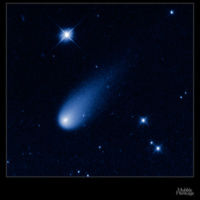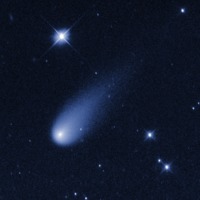Comet ISON
Dublin Core
Title
Subject
Description
This July 4th the solar system is showing off some fireworks of its own.
Superficially resembling a skyrocket, Comet ISON is hurtling toward the Sun at a whopping 48,000 miles per hour.
Its swift motion is captured in this time-lapse movie made from a sequence of pictures taken May 8, 2013, by NASA's Hubble Space Telescope. At the time the images were taken, the comet was 403 million miles from Earth, between the orbits of Mars and Jupiter.
The movie shows a sequence of Hubble observations taken over a 43-minute span, compressed into just five seconds. The comet travels 34,000 miles in this brief video, or 7 percent of the distance between Earth and the Moon. The deep-space visitor streaks silently against the background stars.
Unlike a firework, the comet is not combusting, but in fact is pretty cold. Its skyrocket-looking tail is really a streamer of gas and dust bleeding off the icy nucleus, which is surrounded by a bright, star-like-looking coma. The pressure of the solar wind sweeps the material into a tail, like a breeze blowing a windsock.
As the comet warms while it moves closer to the Sun, its rate of sublimation will increase. The comet will get brighter and the tail will grow longer. The comet is predicted to reach naked-eye visibility in November.
The comet is named after the organization that discovered it, the Russia-based International Scientific Optical Network.
This false-color, visible-light image was taken with Hubble's Wide Field Camera 3.
ABOUT THE OBJECT
Object Name:
Comet ISON
Object Description:
Comet
Distance:
At the time of the Hubble observations on May 8, 2013, the comet was 3.8 astronomical units (354 million miles) from the Sun. The comet was 4.3 astronomical units (403 million miles) from Earth.

